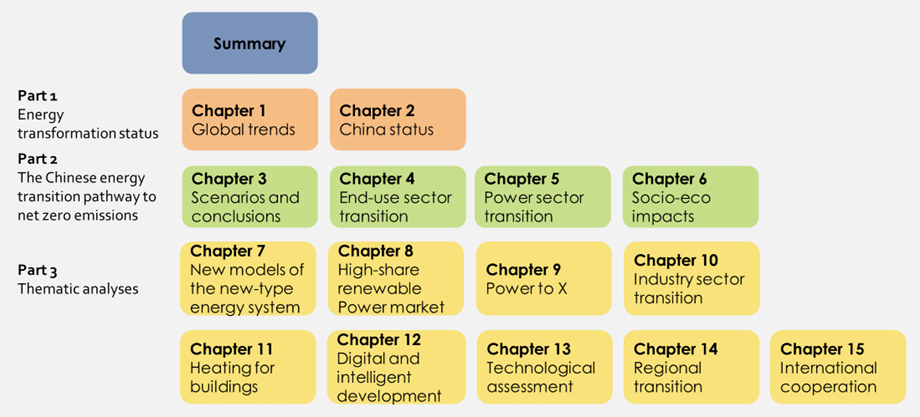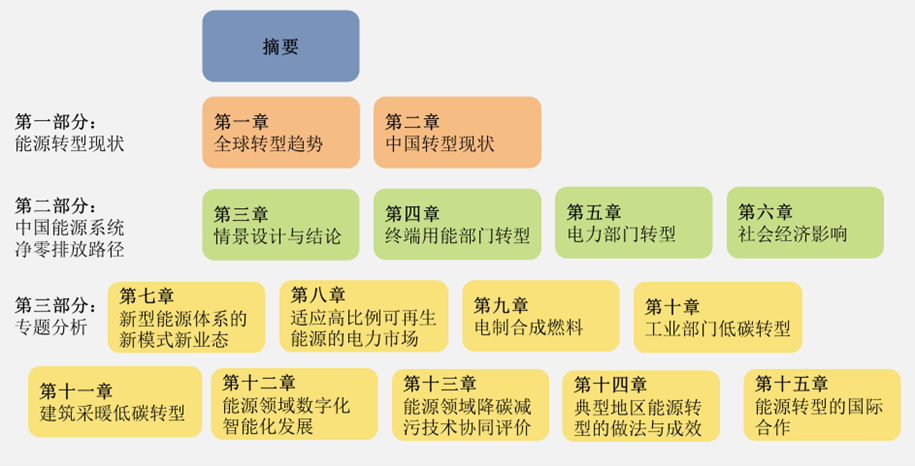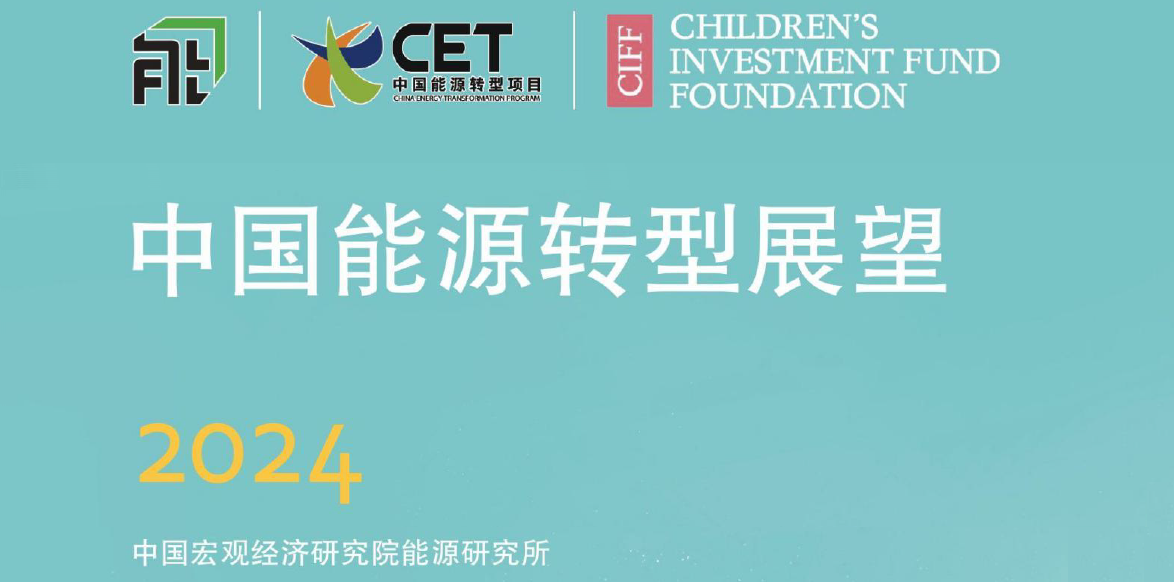China Energy Transformation Outlook 2024 – Executive Summary / 中国能源转型展望2024 – 执行摘要
(中文介绍在下方)
The China Energy Transformation Outlook 2024 (CETO 2024) consists of a summary and three major sections, and will be available soon on the CET website. The Executive Summary of China Energy Transformation Outlook 2024 encapsulates the main report’s key findings and communicates the core essence, allowing it to be read independently.
The China Energy Transformation Outlook 2024 (CETO 2024) reflects China’s latest development situation and, while analysing China’s path towards achievement of its peak carbon and carbon neutrality targets, explores the potential impact of enhanced international cooperation on China’s energy transformation. Through two scenarios, the report examines the technological pathways and prospects of China’s energy transformation under different international cooperation environments. In addition to the scenario analyses, CETO 2024 also carries out thematic studies on hot topics such as building a new energy system, low-carbon industrial transformation of industry, and P-t-X. International partners, including Danish Energy Agency (DEA) and the Centre for Global Energy Policy (CGEP) of Columbia University provided technical support for the model analyses and thematic studies, providing important support for China to understand the latest progress of the global energy transformation and learn from the latest international experience.
How to read CETO 2024
Part I provides a brief analysis of the global climate change and energy transformation landscape (Chapter 1) and reviews the significant changes in China’s system of energy production and consumption over the past decade (Chapter 2).
Part II presents scenario analyses of the outlook for China’s energy system transformation up to 2060, with the goal of achieving carbon neutrality. This section is divided into four chapters. Chapter 3 summarises the outlook for China’s energy system transformation, including the scenario design and main conclusions. Chapter 4 explores the outlook for energy transformation for end-use sectors, including industry, buildings, and transportation. Chapter 5 analyses the outlook for power sector transformation, with a focus on focusing on the development prospects of renewable energy and flexible resources. Chapter 6 examines the impact of China’s energy transformation on its economic transformation and social development.
Part III addresses key topics that have undergone significant changes in recent years and attracted widespread attention in China. It is divided into nine chapters. Chapter 7 describes the new energy models and new business forms related to China’s efforts to build a new energy system. Chapter 8 discusses how to build a power market compatible with a high penetration of renewable energy. Chapter 9 showcases the latest developments in the production of Power to X (incl. hydrogen, ammonia, and methanol fuels) in China and globally. Chapter 10 analyses the prospects for low-carbon, zero-carbon industrial transformation in China. Chapter 11 examines the pathways for low-carbon transformation of space heating in China’s buildings. Chapter 12 showcases the latest policies and cases of China’s promotion of digital and intelligent development in the energy sector. Chapter 13 evaluates the synergies of the effects of key technologies in reducing environmental pollution and carbon emission. Chapter 14 introduces the typical approaches taken by two provinces in central and western China (Shanxi and Yunnan) in promoting the energy transformation. Finally, Chapter 15 analyses the key areas of China’s international cooperation in strengthening the energy transformation.
The analyses in Part III provide more extensive policy, information and technical support for the model development and transformation pathway analysis in Part II.

For readers interested in the modelling analysis, Part II of CETO 2024 provides a more comprehensive and in-depth exploration of the analysis process and detailed conclusions for each key sector. For those interested in specific trending topics, Part III offers standalone chapters that can be read individually.
We hope our outlook report helps you better understand the latest developments in China’s energy transformation and discover new opportunities for enhanced cooperation. Enjoy your reading! We warmly welcome your feedback on the report’s content. Please send your comments to ceto2024@cet.energy.
CETO 2024 – English executive summary
《中国能源转型展望2024》(CETO2024)- 执行摘要
《中国能源转型展望2024》(CETO 2024)由执行摘要和三大部分组成,将在不久之后发布。《中国能源转型展望2024》执行摘要总结了报告的主要结论,是整个报告的精华,可单独阅读。
《中国能源转型展望2024》(CETO 2024)结合中国最新的发展形势,在分析中国实现碳达峰碳中和目标的同时,探讨了加强国际合作对中国能源转型的潜在影响。报告通过设定两个情景,分析了不同国际合作形势下中国能源转型的技术路径和前景。除了情景分析以外,CETO 2024还对构建新型能源体系、工业低碳转型、电制燃料等热点话题开展了专题研究。丹麦能源署(DEA)、美国哥伦比亚大学全球能源政策中心(CGEP)等国际机构为模型分析和专题研究提供了技术支持,为中国了解全球能源转型最新进展,借鉴国际最新经验,提供了重要支撑。
CETO 2024阅读指南
第一部分,简要分析了全球气候变化和全球能源转型形势(第一章),回顾了近十年中国能源生产和消费体系的巨大变化(第二章)。
第二部分,利用模型对2060年前实现碳中和的目标愿景下,中国能源系统的转型前景进行情景分析,主要分为四章。其中,第三章总结了中国能源系统转型的前景,包括情景设计和主要结论;第四章分析了终端用能部门的能源转型前景,主要包括工业、建筑、交通运输等;第五章分析了电力部门的能源转型前景,重点描绘了可再生能源、灵活性资源的发展前景;第六章分析了中国能源转型对中国经济转型和社会发展的影响。
第三部分,主要包含近年在中国发生巨大变化,并受到各方关注的热点话题,主要分为九章。其中,第七章描述了中国构建新型能源体系相关的能源新模式和新业态;第八章探讨了如何建设与高比例可再生能源相适应的电力市场;第九章展示了电制氢、氨、醇等燃料在中国和全球发展的新动态;第十章分析了中国工业低碳零碳转型的前景;第十一章分析了中国建筑采暖领域低碳转型的路径;第十二章展示了中国推动能源领域数字化智能化发展的最新政策和案例;第十三章评价了重点技术减污降碳效果的协同性;第十四章介绍了中国中西部地区两个省份(山西省、云南省)推动能源转型的典型做法;第十五章分析了中国加强能源转型的国际合作重点领域和具体做法。第三部分的分析,为第二部分的模型构建和转型路径分析提供了更加充分的政策、信息和技术支持。

对模型分析感兴趣的读者,可以阅读《中国能源转型展望2024》的第二部分,更全面、深入地了解各重点部门的分析过程和具体结论。对热点话题感兴趣的读者,可以阅读《中国能源转型展望2024》第三部分,各章可以独立阅读。
期待您能通过本报告更好地了解中国能源转型的最新动态,发现加强合作的新机遇。祝您阅读愉快! 我们非常欢迎您对报告内容提供反馈意见。请将您的意见发送到以下邮箱:ceto2024@cet.energy。

